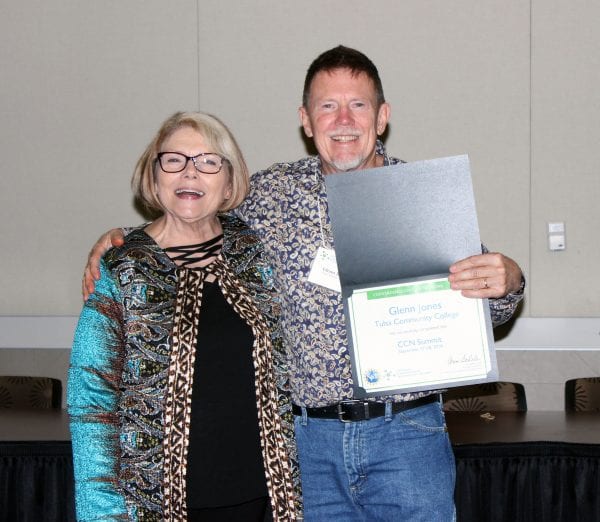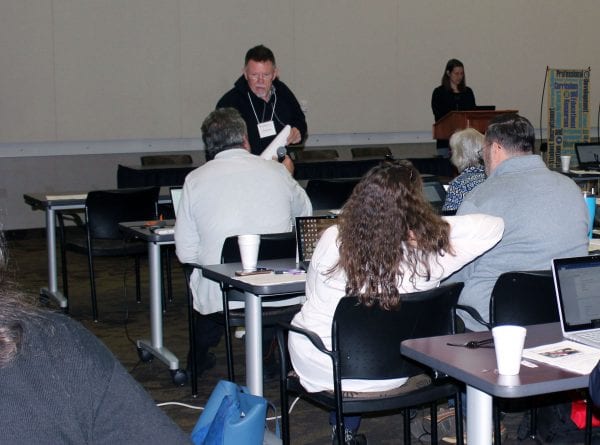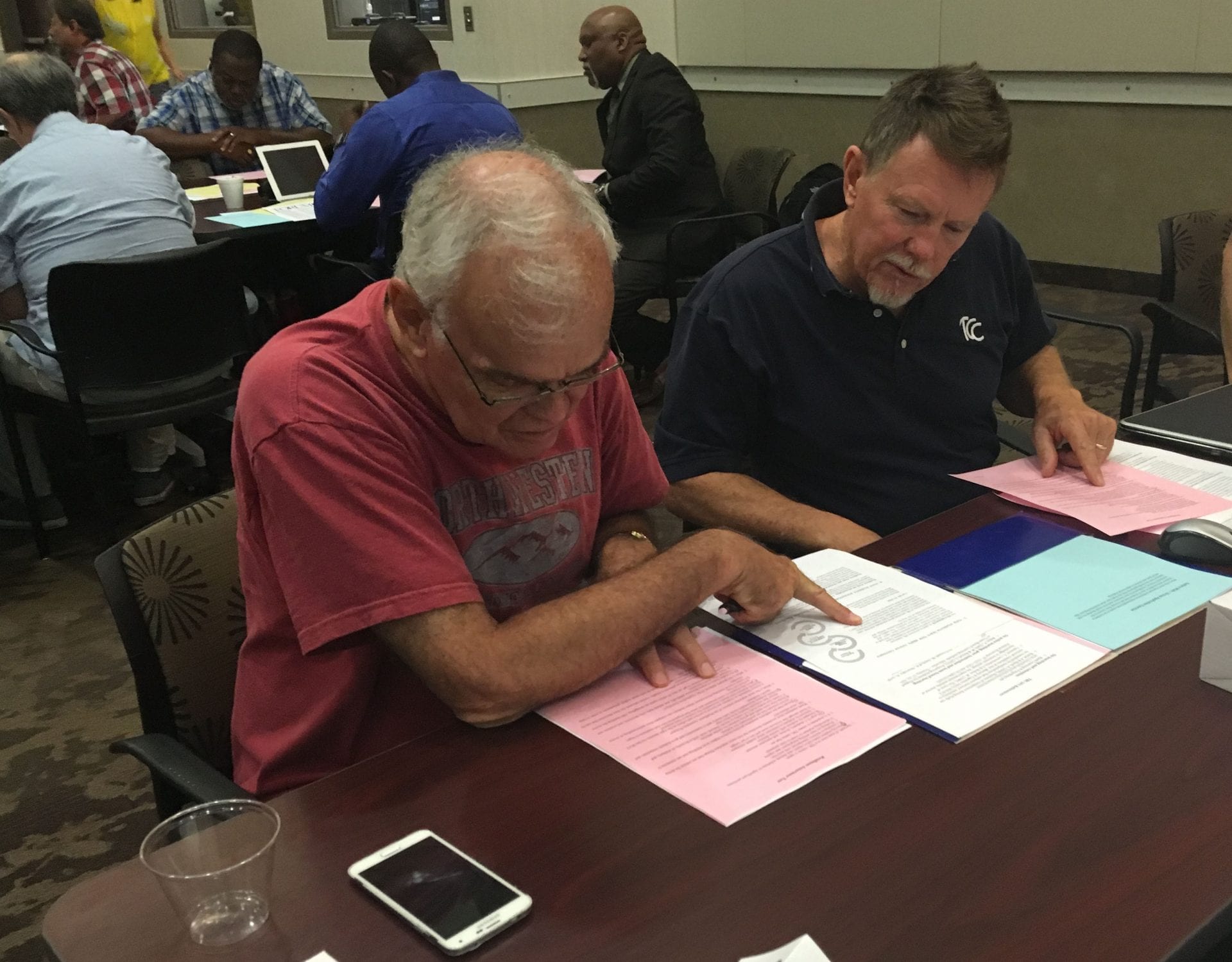CCN Focus: Glenn Jones, Tulsa Community College

Dr. Ann Beheler pictured here with Glenn Jones.
As a part of the National Convergence Technology Center (CTC) featured blogs, we would like to introduce to you some of our professors and instructors in the Convergence College Network (CCN) community. The CCN is a select cohort of community colleges and universities from across the country that connects IT educators with a wealth of resources to enhance their programs. In this week’s Q&A blog, we’re featuring Glenn Jones, Associate Professor of IT/Networking and Cloud Computing at Tulsa Community College in Tulsa, OK.
What do you teach? IT Networking and Cloud Computing program, including Linux, Cisco, Wireless Networking, and Info Sec. courses.
How long have you been a teacher? I have been teaching IT since 1998. Although I did teach Physical Science in high schools for a couple of years, there were no other colleges for me. I had worked as an electronic technician, manufacturing supervisor, and field engineer for Telex Computer Products for 19 years, got my BS in Science Ed, and started teaching at TCC as an adjunct in 1998; went full time in 2000. I picked up my MS in Computer Science (Cyber Security) at the University of Tulsa in 2004.
What sparked your interest in teaching? It is a spiritual gift. Studying and teaching is fun!
What is the secret to successfully teaching IT to students? Piquing student interest by presenting topics in multiple formats, engaging them in hands-on lab groups, allowing them to learn by making mistakes and troubleshooting, and submitting structured lab reports.

Glenn Jones participates in a CCN Summit Presentation.
Typically, the way I present topics in multiple formats is as follows: First, I select a textbook or online material which are appropriate for the students’ skill level. I read the assignment myself and create PowerPoint slides which I can use to enhance my presentation to the students, supplementing with additional resources such as videos as necessary. Next, I narrate the slides, so the students can access the material online at their convenience within the weekly deadlines, and still be able to hear my “lecture”.
After every 2 or 3 slides, I include a few review questions, which deals with the material on those slides. I provide a template which includes all of the review questions, and the students answer them on the template. These are great for exam reviews, since the questions and answers are together in one place. It makes grading very easy for me, since I can download all of the submissions for a given assignment at once, and they all have a very similar format. I can spot check and grade all of the assignments very quickly. Once the students have submitted an assignment, they are immediately able to go to the solutions folder and compare their answers with the instructor’s.
Next, students must perform a lab which deals with the material. If the class is online, they either perform the lab remotely on a class server, or on virtual machines which they create at home. My Cisco ICND2 students access our CCNA lab remotely and perform labs on real Cisco routers and switches which I have cabled up for them. They can work alone or in groups if they wish, but each student must submit his or her own lab report. This helps to solidify what has been learned in that particular lab. Students must also complete a network diagram of the lab configuration.
For on-campus labs, I place the students into one of 4 diverse groups for weekly 3-hour hands-on labs. In order to learn soft skills, the students serve in different roles—director, tech, materials manager, and recorder, and rotate roles each week. I provide lab instructions, and, at the beginning of each lab, we go over the instructions together, in order to get the gist of the learning process. From that point on, the students work together to accomplish the goals of the lab, troubleshooting together as often as necessary. The director reads the lab instructions and oversees the lab, while the technician performs most of the actual configuration. Materials manager is responsible for acquiring and returning equipment such as routers, switches, spare computers, power and Ethernet cables, while the recorder is responsible to get data necessary to answer all lab questions and distribute it to all members of the group. Again, each student is responsible for his / her own lab report including the network diagram. A rubric is provided which shows how to earn the maximum possible points in each of about 8 areas.
Another great learning format, of course is exams. Most courses have a Midterm and a Final Exam with several types of question. My favorite is matching—usually with about 8 parts. Another favorite question format is sequencing (place in the correct order), but I also sprinkle in a few multiple choices and fill in the blank. I save essay questions for the English professors.
Weekly discussion forums, with mandatory participation provide another learning format. I post forum “seeds” to get them started, but students are free to discuss personal experience with the weekly topic, news, jobs, certifications, requests or offers to help with assignments, labs, or anything else which is related to the course or topic.
Tours are another avenue for learning. For example, in my Wireless Networking course, students perform hands-on labs with wireless PAN and LAN technologies such as IR, Bluetooth, WiFi, and NFC, but for wireless WANs, we may take a tour of the US Cellular MTSO and cell site. In the Cloud Computing class, we tour TulsaConnect, a local Cloud service provider.
I also provide resources & links in our course management system, which is just what it sounds like, for “how-to” instructions and for further research.
Projects are common in some online courses, such as Enterprise Security, which teaches students Cyber Security from a management perspective. One example is the Physical Security Analysis project, wherein students must analyze the physical security of their home or place of business (with supervisor’s permission). Other examples are Policies, Risk Management, and Social Engineering.
After students have heard, seen, read, discussed, viewed videos, answered questions, performed labs, written lab reports, performed projects, and taken exams, it usually sinks in.
What’s the biggest challenge of teaching IT? Marketing my program so that the classes make. Another challenge is updating and maintaining all of the labs and equipment. A third problem is keeping up with all of the IT changes in 10 classes.
Have you always been a teacher? If you had a job in industry prior to teaching what was it? No. I was a printed circuit board technician, manufacturing supervisor, and Field Engineer for Telex Computer Products for 19 years.
When I worked for Telex Computer Products, our slogan was “The Peripheral Company”, making everything to go wi

Telex Computer Products – “You may recall seeing them during football games worn by coaches and broadcast personnel.” ~ Glenn Jones
th IBM CPUs–tape drive systems, disk drive systems, printer systems, and terminal systems.
They also had an audio division which made headsets, among other things. You may recall seeing them on football games, worn by coaches and broadcast personnel.
You can read about Telex here.
A hostile takeover by Asher Edelman in 1987 led to the company’s demise in 1991, when I was laid off. I went back to school, earning an AS in Chemistry from Tulsa Community College, and ended up with a BS in science education. At that time, TCC was looking for adjuncts to teach IT, and it was a good fit.

Pictured left to right, Dwight Watt and Glenn Jones work together on a project during a CCN Sunday meeting, a day prior to Summer Working Connections.
How has the CCN helped you? We have only been a member for a few months, but CCN has already provided numerous ideas for overcoming challenges. CCN has provided affordable training opportunities which were not available anywhere else. It has also provided the opportunity to collaborate and share with other IT community college professors in an atmosphere of camaraderie.
What is the best thing about being a part of CCN? Esprit de corps of like-minded community college faculty across the country, who face similar challenges.
How do you see the IT landscape changing in the next 5 years? I think virtualization and cloud services will be ubiquitous, with more emphasis on Big Data analysis.
Anything else we should know but didn’t ask about? I have been attending the Working Connections workshops for many years, and they are awesome! Through its planning and foresight, Working Connections has provided me with distraction-free opportunities to keep up with some of the ubiquitous changes in IT. Sharing with like-minded peers from all over the country has been invaluable. The leadership is superb, and the training is excellent. What’s not awesome about that?
